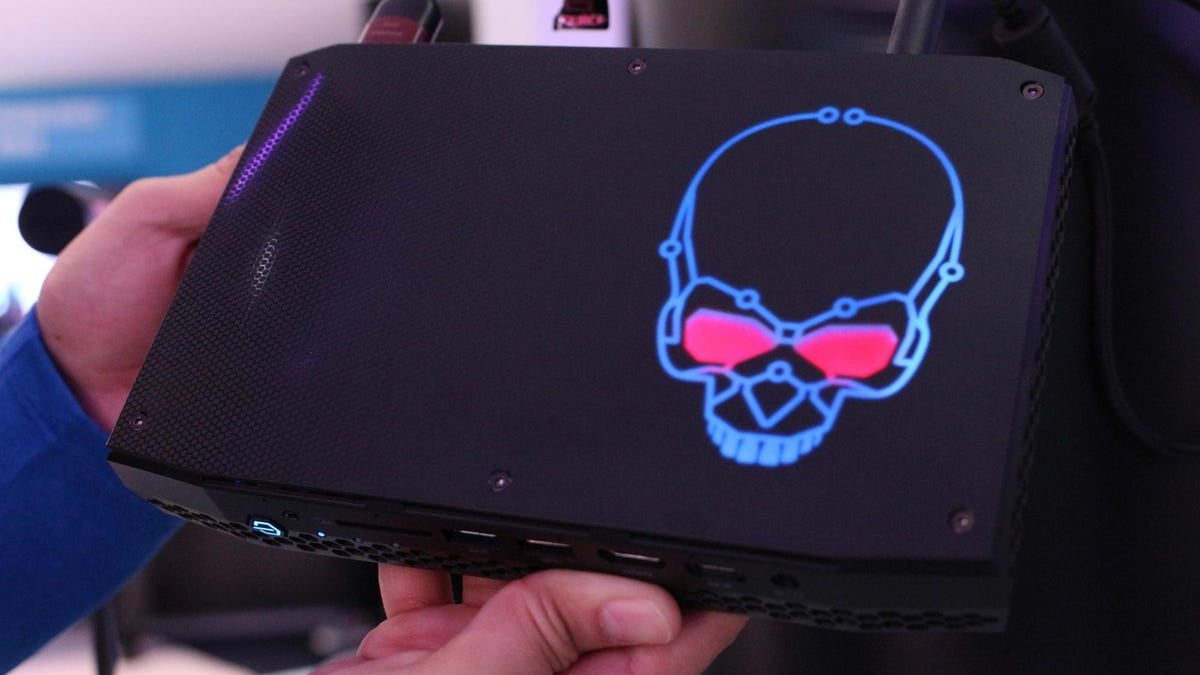Intel Hades Canyon NUC is the smallest VR gaming rig I've ever seen (hands-on)
I want one.

Yes, that's a glowing skull.
I love miniature gaming PCs, and Intel may have just trumped them all here at CES 2018 in Las Vegas.
This is the Intel Hades Canyon NUC, a VR-ready gaming rig that's just 1.2 liters in volume. It's small enough to fit into a messenger bag, or even a very large purse -- and yet it's got enough power to play real VR games or drive up to six (!) monitors.
I can attest to that, because I strapped on an Oculus Rift connected to the Hades Canyon myself. The game Echo Arena looked butter-smooth on the system I tried on the CES show floor.
Smallest VR gaming rig I’ve ever seen. @Intel Hades Canyon NUC with integrated @AMD Radeon RX Vega M graphics. #CES2018 https://t.co/K5DcDPjlAD pic.twitter.com/QccAqOd2GZ
— Sean @ #CES2018 (@StarFire2258) January 9, 2018
I even got Intel to open up the back of its demo station, to prove it was running on this tiny box instead of a hidden gaming rig. Sure enough.
These benchmarks seem cherry-picked to favor AMD over Nvidia, but they're still impressive.
How is this sorcery possible? It's thanks to one of the most surprising and unlikely pairings in silicon history: a new Intel processor with built-in AMD Radeon graphics inside.
Specifically, the AMD Radeon RX Vega M GH, a graphics chip which Intel claims has as much horsepower as a dedicated Nvidia GeForce GTX 1060 Max-Q part -- at least in games that generally favor AMD.
But apparently, it wasn't exactly a matter of two famous rivals teaming up: In a posh lounge on the second story of Intel's giant booth -- where fresh chocolate chip cookies were served -- Intel graphics marketing director John Webb told me that Intel basically paid AMD to make it happen, similar to how Sony and Microsoft paid for AMD graphics to appear inside the PlayStation 4 and Xbox One.
"This is strictly acquired... it's a component that Intel has purchased," Webb told us. AMD says that's accurate, but wants you to know it designed the custom part in collaboration with Intel.
And these powerful new Intel-AMD chips will appear in new laptops as well -- the 15-inch HP Spectre X360 and Dell XPS 15 2-in-1 announced here at CES each sport a 65-watt version of the chip, weaker than the 100-watt TDP version in the Hades Canyon NUC.
(Unfortunately, none of those laptops are running game demos here at the show. I checked everywhere.)
But I digress. You came here to learn about the smallest VR gaming rig I'd ever seen, and we're not quite done with the Hades Canyon yet. Check out all these ports:
The blurry ones on the left: a pair of Thunderbolt 3 ports, four lanes each, which support external graphics for added futureproofing. Plus an optical audio jack.
And here's the full spec sheet:
The Hades Canyon NUC will cost $1,000 in the US this spring, though you'll need to add your own operating system and storage. That converts to roughly £740 or AU$1,270; we don't have info on international availability yet. There'll also be a cheaper version (see spec sheet above) with the somewhat weaker processor.
And just in case a glowing skull isn't your thing (but why not?) you should probably know that the Hades Canyon comes with a second, plain black faceplace. Or, you can just turn the fancy lighting off.

